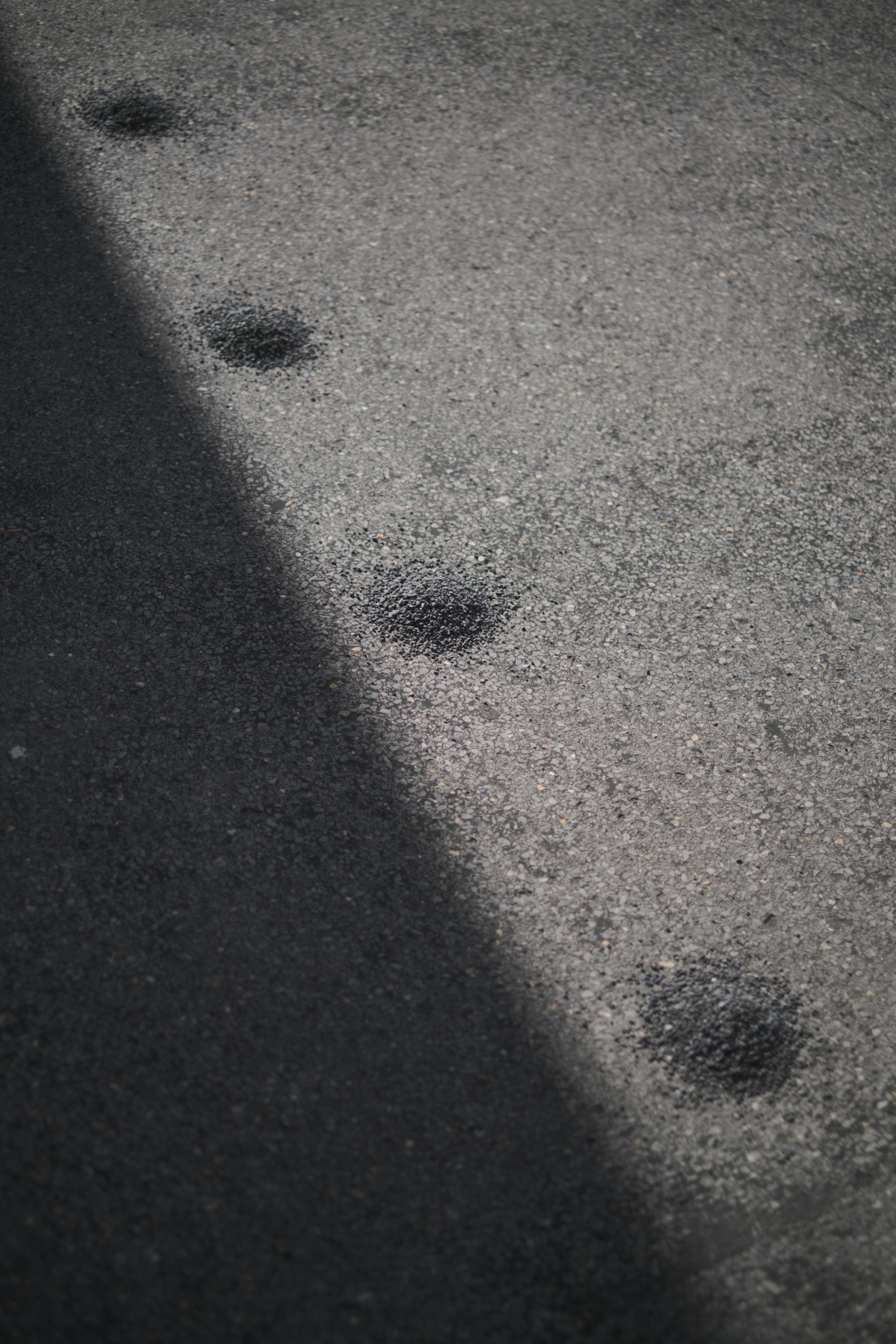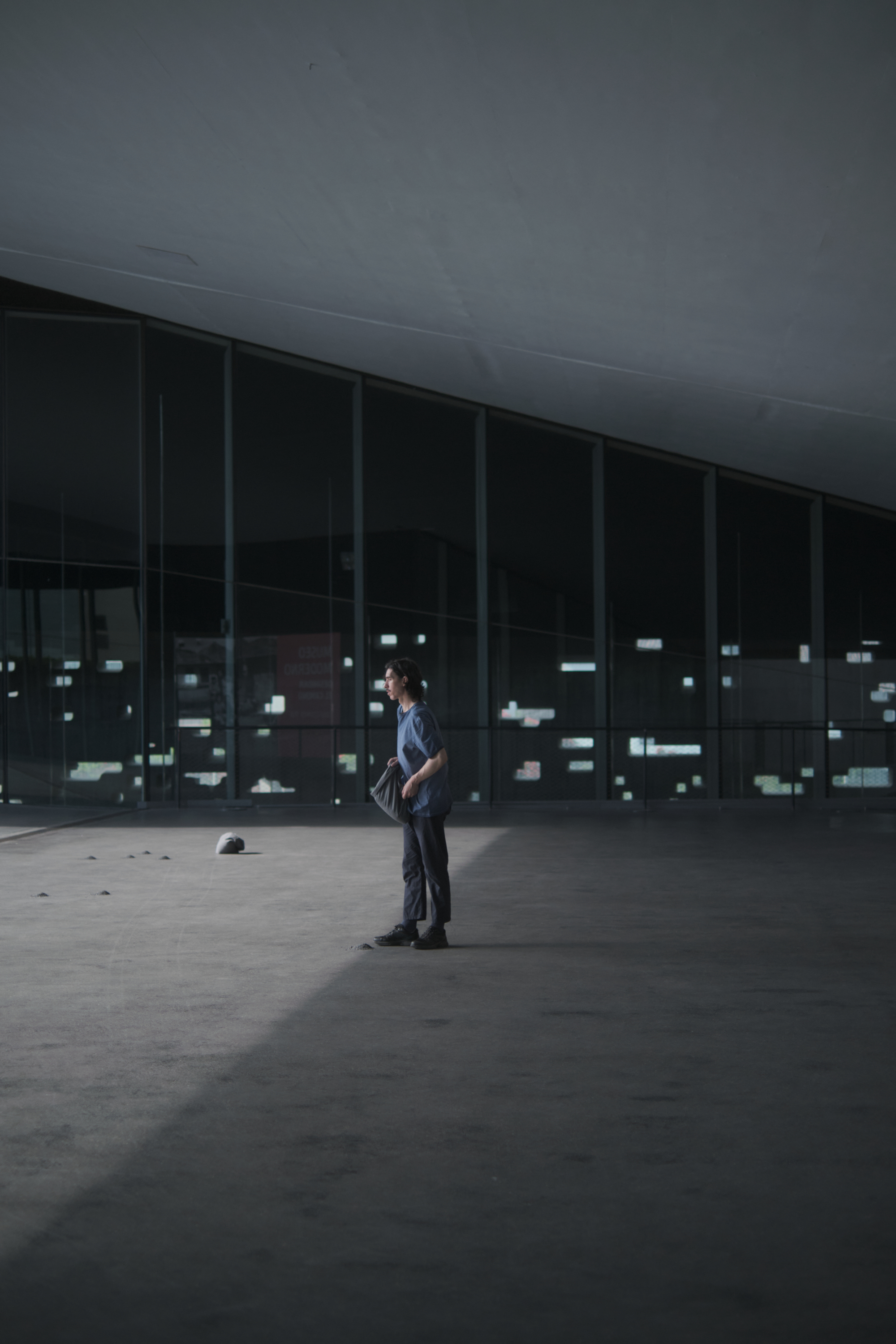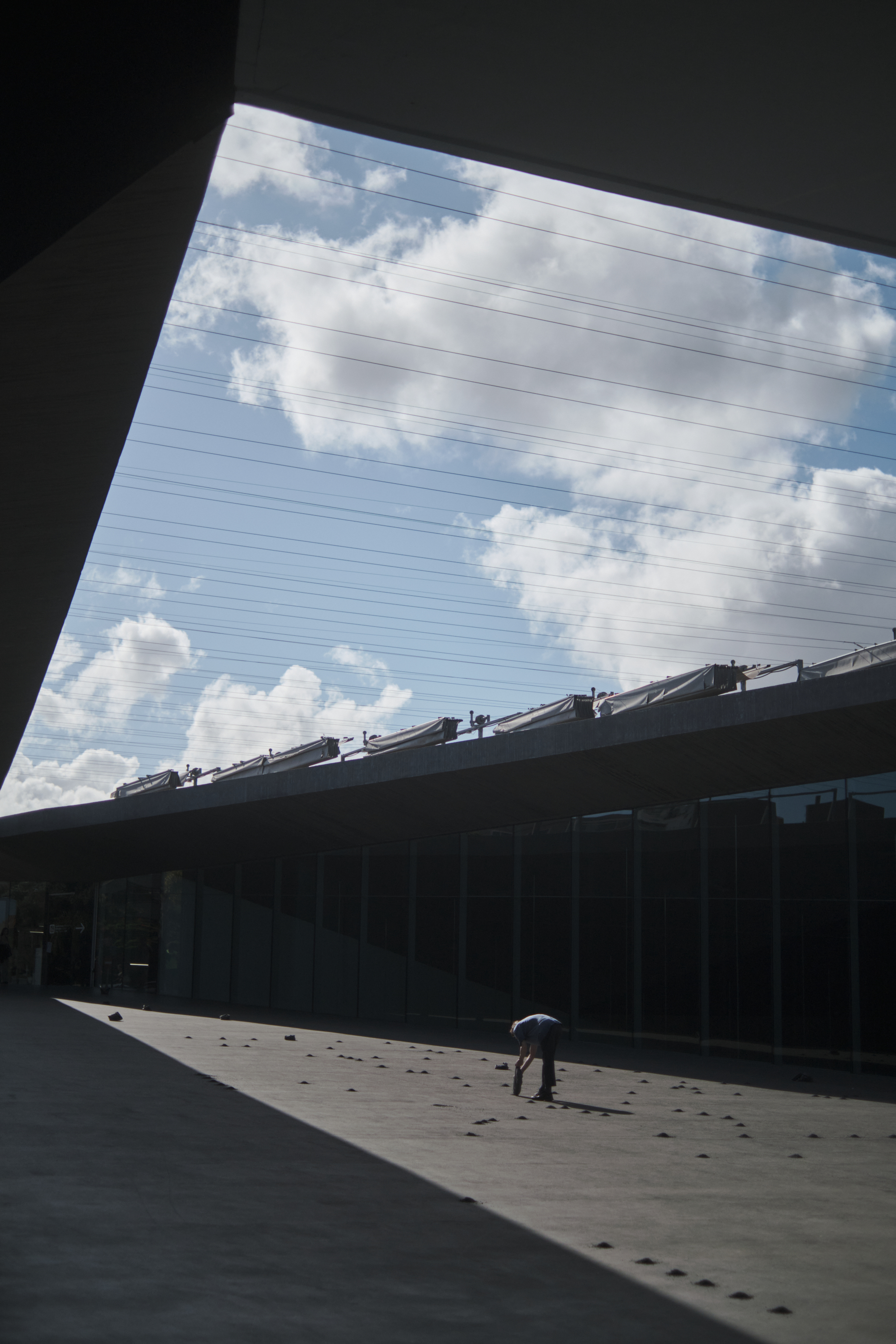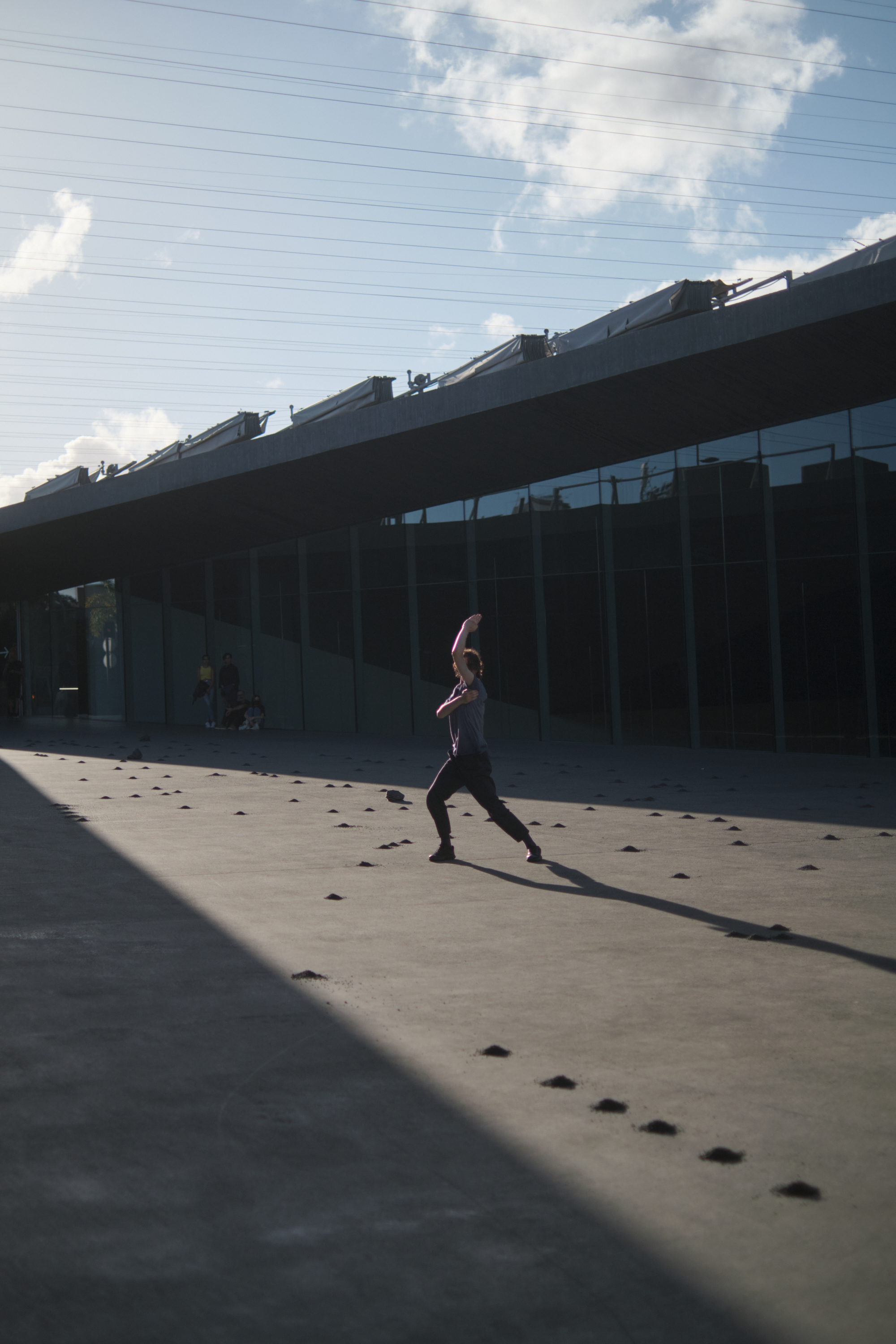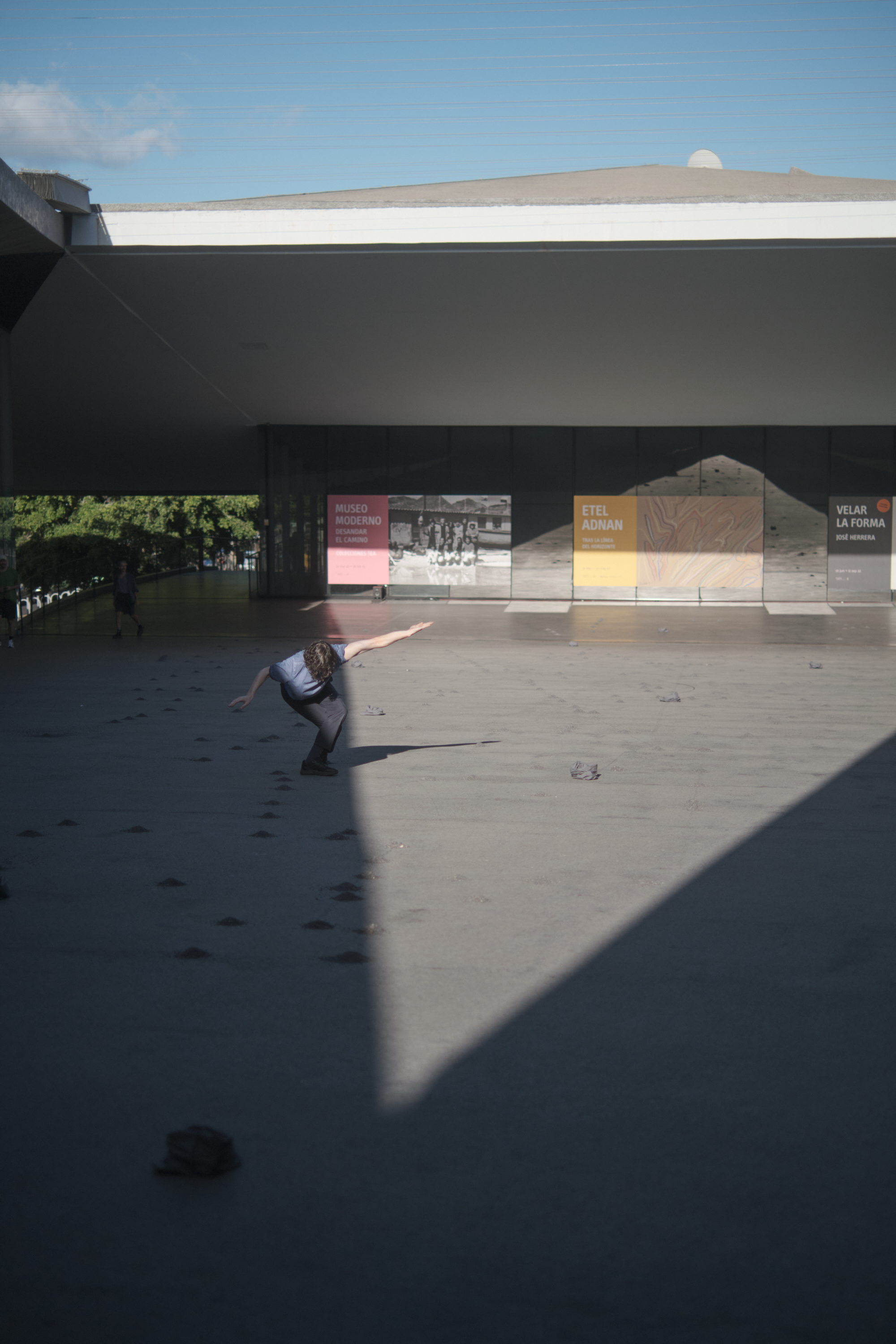Pensar el museo como un cuerpo.
Instalación / performance para el Museo TEA de Tenerife. Dentro del marco del Programa “Por asalto”, curado por Javier Arocena.
Un codigo indescifrable Texto de Javier Arocena / Fotos de Derek Pedros
![]() Representacion de la vista superior del museo después de la intervención
Representacion de la vista superior del museo después de la intervención
El propio edificio va señalando a través de sus particularidades un posible código.
Cuerpo que es código / Cuerpo como topografía.
El cuerpo-artista se lee a sí mismo del mismo modo y traduce esta forma de lectura a la arquitectura/estructura física, buscando las convergencias y destacando los surcos en hueso, carne y piel. Este modo de observar la cartografía física resulta en un mapeado interno de la materia corpórea que será continuamente leído, interpretado, cuestionado y reconducido. Una identidad cambiante, que obedece a la continua relectura, desde el cuestionar y enfocar, por parte de ejecutante y espectador.
El artista del movimiento es un ser para la mirada. Es una corporalidad que pone en movimiento el pensamiento que mira ya que el hecho visual no sucede en el globo ocular y no es un acto concreto, sino un proceso de pensamiento. El cuerpo del artista observa a su vez al espectador con lo que el ojo que mira se convierte en ojo mirado, transformando la relación bidireccional espectador - ejecutante en un verse ver.
Pero puede el cuerpo inmóvil de un espectador entrar en diálogo efectivo con el cuerpo activo de la ejecutante?
La acción escénica transcurre en un tiempo durante el cual la espectadora es sustraída de su ritmo cotidiano, se produce una detención que traslada al cuerpo de la espectadora a una inmovilidad, una suspensión. Dicho tiempo suspendido activa la mirada bidireccional de espectadora-ejecutante.
Ambas toman parte en un acto que es inmediatamente colectivo, ya que no existe un único espectador ni una única forma de mirar.
[ENG]
Think of the museum as a body.
Installation / performance for the TEA Museum of Tenerife. Within the framework of the “By assault” Program, curated by Javier Arocena.
The indecipherable code
The building itself indicates a possible code through its particularities. A reading of the architectural epidermis can be made and the affectations of structural settlements, materiality, time, environment, climatology and uses are considered.
This memory translates into fissures or cracks. The artist, in a totally random way, interprets and graphs the signals that the building itself seems to indicate, giving rise to a totally open code.
It will change every day when the artist's eye makes a new reading of the surface and perceives new marks on the skin of the building. It is a rereading completely stripped of conscious memory, in which the code is rewritten in each session.
The resulting grid of dots allows for an infinite number of possible combinations and interpretations, the code transforms with each new interlocutor and their own individualized gaze.
The signs of what was there all the time but that in reality does not exist and that takes shape in the individual will of each interlocutor are revealed. An exercise of impossible looks, towards the interior of the body and process and even the hidden part of the action.
This would be the building's grapheme, its signature, its tag or label. Being read by others, who interpret and identify the object of contemplation. Graffiti, or signature, or identity seal that wants to expand and make itself known beyond the individual in the face of the problem of saying "I". The sign as signifier of multiple possible meanings.
For the writing, 80kg of sand from La Nea beach (Tenerife) was used. The natural resources of the territory are used to write the territory itself.
The resulting flat diagram creates a series of volumes, protuberances that build a communicating space that can be traversed, danced, inhabited.
A variable code that can also be read from above, like a geoglyph, expanding its scope. The indecipherable code only makes sense in individualized reading, in the intimate bond that is generated from observing the body or inhabiting space.
Translating what is already present from the past and future, which will only exist with the interpellating capacity of the plot. This manages to vary the way of looking at the territory, making the viewer stop and, from questioning, build their possible versions.
Artistic action is capable of carrying out the political gesture of varying the paths and the viewer's gaze. Once the actions are completed, they are diluted. The 80 kg of sand return to their place of origin.
Body as code / Body as topography.
The body-artist reads itself in the same way and translates this form of reading to the architecture/physical structure, looking for convergences and highlighting the grooves in bone, flesh and skin. This way of observing the physical cartography results in an internal mapping of corporeal matter that will be continuously be read, interpreted, questioned and redirected. A changing identity, which obeys the continuous rethought, through questioning and focusing, of the performer and the spectator.
The artist of movement is a being for the gaze. It is a corporality that sets in motion the thought that looks, since the visual fact does not happen in the eyeball and it is not a concrete act, but a thinking process. The artist's body also observes the viewer, so that the eye that looks becomes the eye that is being looked at, transforming the bidirectional relationship between spectator and performer into seeing oneself see.
But can the motionless body of a spectator enter into an effective dialogue with the active body of the performer?
The scenic action takes place in a time during which the spectator is subtracted from her daily rhythm, a deceleration occurs that moves the body of the spectator to an immobility, a suspension. This suspended time activates the bidirectional gaze of the spectator-performer.
Both take part in an act that is immediately collective, since there is not a single spectator or a single way of looking.
Instalación / performance para el Museo TEA de Tenerife. Dentro del marco del Programa “Por asalto”, curado por Javier Arocena.
Un codigo indescifrable Texto de Javier Arocena / Fotos de Derek Pedros
 Representacion de la vista superior del museo después de la intervención
Representacion de la vista superior del museo después de la intervenciónEl propio edificio va señalando a través de sus particularidades un posible código.
Se hace una lectura de la epidermis
arquitectónica y se consideran las afectaciones de asentamientos estructurales, materialidad, tiempo, ambiente, climatología y usos.
Esta memoria se traduce en fisuras, grietas.
La artista, de forma totalmente aleatoria, va interpretando y grafiando las señales que el
propio edificio parece indicar, dando lugar a un código totalmente abierto.
Éste irá mutando cada día cuando el ojo de la intérprete
haga una nueva lectura de la superficie y percibe nuevas marcas en la piel del edificio.
Se trata de una relectura completamente
despojada de memoria consciente, en la que el código es reescrito en cada sesión.
La trama de puntos resultante permite infinidad
de combinaciones e interpretaciones posibles, el código se transforma con cada nuevo interlocutor y su propia mirada
individualizada.
Se revelan los signos de aquello que estuvo ahí todo el tiempo pero que en realidad no existe y que toma forma en
la voluntad individual de cada interlocutor.
Un ejercicio de miradas imposibles, hacia el interior de cuerpo y proceso e incluso de la
parte escondida de la acción.
Éste sería el grafema del edificio, su firma, su tag o etiqueta. Ser leído por otras, que interpretan e identifican el objeto de
contemplación.
Graffiti, o firma, o sello de identidad que quiere expandirse y darse a conocer más allá del individuo ante la
problemática de decir “yo”. El signo como significante de múltiples significados posibles.
Cuerpo que es código / Cuerpo como topografía.
El cuerpo-artista se lee a sí mismo del mismo modo y traduce esta forma de lectura a la arquitectura/estructura física, buscando las convergencias y destacando los surcos en hueso, carne y piel. Este modo de observar la cartografía física resulta en un mapeado interno de la materia corpórea que será continuamente leído, interpretado, cuestionado y reconducido. Una identidad cambiante, que obedece a la continua relectura, desde el cuestionar y enfocar, por parte de ejecutante y espectador.
El artista del movimiento es un ser para la mirada. Es una corporalidad que pone en movimiento el pensamiento que mira ya que el hecho visual no sucede en el globo ocular y no es un acto concreto, sino un proceso de pensamiento. El cuerpo del artista observa a su vez al espectador con lo que el ojo que mira se convierte en ojo mirado, transformando la relación bidireccional espectador - ejecutante en un verse ver.
Pero puede el cuerpo inmóvil de un espectador entrar en diálogo efectivo con el cuerpo activo de la ejecutante?
La acción escénica transcurre en un tiempo durante el cual la espectadora es sustraída de su ritmo cotidiano, se produce una detención que traslada al cuerpo de la espectadora a una inmovilidad, una suspensión. Dicho tiempo suspendido activa la mirada bidireccional de espectadora-ejecutante.
Ambas toman parte en un acto que es inmediatamente colectivo, ya que no existe un único espectador ni una única forma de mirar.
[ENG]
Think of the museum as a body.
Installation / performance for the TEA Museum of Tenerife. Within the framework of the “By assault” Program, curated by Javier Arocena.
The indecipherable code
The building itself indicates a possible code through its particularities. A reading of the architectural epidermis can be made and the affectations of structural settlements, materiality, time, environment, climatology and uses are considered.
This memory translates into fissures or cracks. The artist, in a totally random way, interprets and graphs the signals that the building itself seems to indicate, giving rise to a totally open code.
It will change every day when the artist's eye makes a new reading of the surface and perceives new marks on the skin of the building. It is a rereading completely stripped of conscious memory, in which the code is rewritten in each session.
The resulting grid of dots allows for an infinite number of possible combinations and interpretations, the code transforms with each new interlocutor and their own individualized gaze.
The signs of what was there all the time but that in reality does not exist and that takes shape in the individual will of each interlocutor are revealed. An exercise of impossible looks, towards the interior of the body and process and even the hidden part of the action.
This would be the building's grapheme, its signature, its tag or label. Being read by others, who interpret and identify the object of contemplation. Graffiti, or signature, or identity seal that wants to expand and make itself known beyond the individual in the face of the problem of saying "I". The sign as signifier of multiple possible meanings.
For the writing, 80kg of sand from La Nea beach (Tenerife) was used. The natural resources of the territory are used to write the territory itself.
The resulting flat diagram creates a series of volumes, protuberances that build a communicating space that can be traversed, danced, inhabited.
A variable code that can also be read from above, like a geoglyph, expanding its scope. The indecipherable code only makes sense in individualized reading, in the intimate bond that is generated from observing the body or inhabiting space.
Translating what is already present from the past and future, which will only exist with the interpellating capacity of the plot. This manages to vary the way of looking at the territory, making the viewer stop and, from questioning, build their possible versions.
Artistic action is capable of carrying out the political gesture of varying the paths and the viewer's gaze. Once the actions are completed, they are diluted. The 80 kg of sand return to their place of origin.
Body as code / Body as topography.
The body-artist reads itself in the same way and translates this form of reading to the architecture/physical structure, looking for convergences and highlighting the grooves in bone, flesh and skin. This way of observing the physical cartography results in an internal mapping of corporeal matter that will be continuously be read, interpreted, questioned and redirected. A changing identity, which obeys the continuous rethought, through questioning and focusing, of the performer and the spectator.
The artist of movement is a being for the gaze. It is a corporality that sets in motion the thought that looks, since the visual fact does not happen in the eyeball and it is not a concrete act, but a thinking process. The artist's body also observes the viewer, so that the eye that looks becomes the eye that is being looked at, transforming the bidirectional relationship between spectator and performer into seeing oneself see.
But can the motionless body of a spectator enter into an effective dialogue with the active body of the performer?
The scenic action takes place in a time during which the spectator is subtracted from her daily rhythm, a deceleration occurs that moves the body of the spectator to an immobility, a suspension. This suspended time activates the bidirectional gaze of the spectator-performer.
Both take part in an act that is immediately collective, since there is not a single spectator or a single way of looking.
Video cortesia del Museo TEA
![]()
![]()
![]()
![]()
![]()
![]()
![]()
![]()
![]()
![]()
![]()
![]()
![]()


